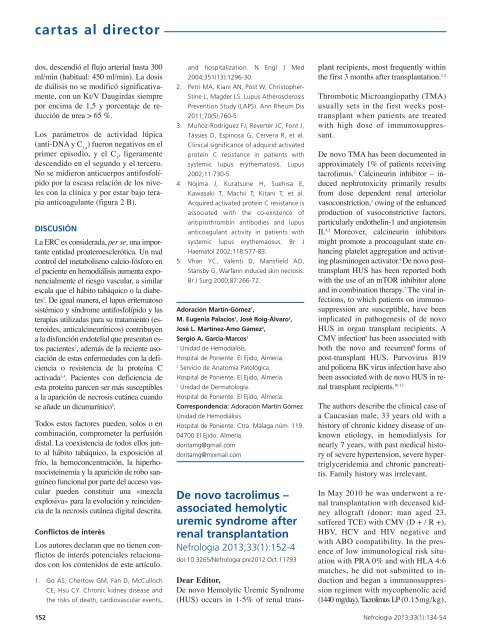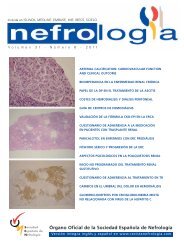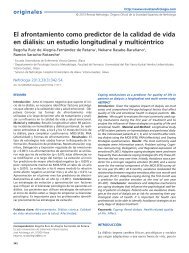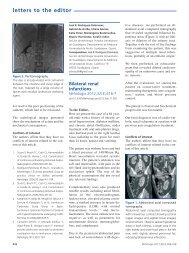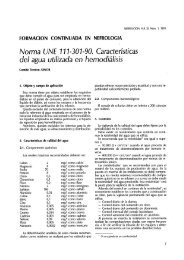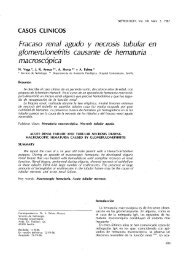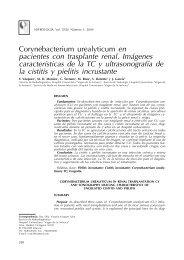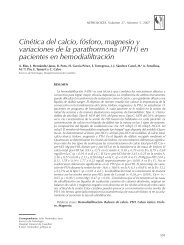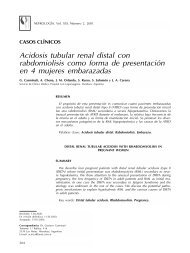PDF Número - NefrologÃa
PDF Número - NefrologÃa
PDF Número - NefrologÃa
You also want an ePaper? Increase the reach of your titles
YUMPU automatically turns print PDFs into web optimized ePapers that Google loves.
cartas al director<br />
Dear Editor,<br />
De novo Hemolytic Uremic Syndrome<br />
(HUS) occurs in 1-5% of renal transdos,<br />
descendió el flujo arterial hasta 300<br />
ml/min (habitual: 450 ml/min). La dosis<br />
de diálisis no se modificó significativamente,<br />
con un Kt/V Daugirdas siempre<br />
por encima de 1,5 y porcentaje de reducción<br />
de urea > 65 %.<br />
Los parámetros de actividad lúpica<br />
(anti-DNA y C 3,4<br />
) fueron negativos en el<br />
primer episodio, y el C 3<br />
, ligeramente<br />
descendido en el segundo y el tercero.<br />
No se midieron anticuerpos antifosfolípido<br />
por la escasa relación de los niveles<br />
con la clínica y por estar bajo terapia<br />
anticoagulante (figura 2 B).<br />
DISCUSIÓN<br />
La ERC es considerada, per se, una importante<br />
entidad proateroesclerótica. Un mal<br />
control del metabolismo calcio-fósforo en<br />
el paciente en hemodiálisis aumenta exponencialmente<br />
el riesgo vascular, a similar<br />
escala que el hábito tabáquico o la diabetes<br />
1 . De igual manera, el lupus eritematoso<br />
sistémico y síndrome antifosfolípido y las<br />
terapias utilizadas para su tratamiento (esteroides,<br />
anticalcineurínicos) contribuyen<br />
a la disfunción endotelial que presentan estos<br />
pacientes 2 , además de la reciente asociación<br />
de estas enfermedades con la deficiencia<br />
o resistencia de la proteína C<br />
activada 3,4 . Pacientes con deficiencia de<br />
esta proteína parecen ser más susceptibles<br />
a la aparición de necrosis cutánea cuando<br />
se añade un dicumarínico 5 .<br />
Todos estos factores pueden, solos o en<br />
combinación, comprometer la perfusión<br />
distal. La coexistencia de todos ellos junto<br />
al hábito tabáquico, la exposición al<br />
frío, la hemoconcentración, la hiperhomocisteinemia<br />
y la aparición de robo sanguíneo<br />
funcional por parte del acceso vascular<br />
pueden constituir una «mezcla<br />
explosiva» para la evolución y reincidencia<br />
de la necrosis cutánea digital descrita.<br />
Conflictos de interés<br />
Los autores declaran que no tienen conflictos<br />
de interés potenciales relacionados<br />
con los contenidos de este artículo.<br />
1. Go AS, Chertow GM, Fan D, McCulloch<br />
CE, Hsu CY. Chronic kidney disease and<br />
the risks of death, cardiovascular events,<br />
and hospitalization. N Engl J Med<br />
2004;351(13):1296-30.<br />
2. Petri MA, Kiani AN, Post W, Christopher-<br />
Stine L, Magder LS. Lupus Atherosclerosis<br />
Prevention Study (LAPS). Ann Rheum Dis<br />
2011;70(5):760-5.<br />
3. Muñoz-Rodríguez FJ, Reverter JC, Font J,<br />
Tàssies D, Espinosa G, Cervera R, et al.<br />
Clinical significance of adquirid activated<br />
protein C resistance in patients with<br />
systemic lupus erythematosis. Lupus<br />
2002;11:730-5.<br />
4. Nojima J, Kuratsune H, Suehisa E,<br />
Kawasaki T, Machii T, Kitani T, et al.<br />
Acquired activated protein C resistance is<br />
associated with the co-existence of<br />
antiprothrombin antibodies and lupus<br />
anticoagulant activity in patients with<br />
systemic lupus erythemaosus. Br J<br />
Haematol 2002;118:577-83.<br />
5. Vhan YC, Valenti D, Mansfield AO,<br />
Stansby G. Warfarin induced skin necrosis.<br />
Br J Surg 2000;87:266-72.<br />
Adoración Martín-Gómez 1 ,<br />
M. Eugenia Palacios 1 , José Roig-Álvaro 2 ,<br />
José L. Martínez-Amo Gámez 3 ,<br />
Sergio A. García-Marcos 1<br />
1<br />
Unidad de Hemodiálisis.<br />
Hospital de Poniente. El Ejido, Almería.<br />
2<br />
Servicio de Anatomía Patológica.<br />
Hospital de Poniente. El Ejido, Almería.<br />
3<br />
Unidad de Dermatología.<br />
Hospital de Poniente. El Ejido, Almería.<br />
Correspondencia: Adoración Martín Gómez<br />
Unidad de Hemodiálisis.<br />
Hospital de Poniente. Ctra. Málaga núm. 119.<br />
04700 El Ejido. Almería.<br />
doritamg@gmail.com<br />
doritamg@mixmail.com<br />
De novo tacrolimus –<br />
associated hemolytic<br />
uremic syndrome after<br />
renal transplantation<br />
Nefrologia 2013;33(1):152-4<br />
doi:10.3265/Nefrologia.pre2012.Oct.11793<br />
plant recipients, most frequently within<br />
the first 3 months after transplantation. 1,2<br />
Thrombotic Microangiopathy (TMA)<br />
usually sets in the first weeks posttransplant<br />
when patients are treated<br />
with high dose of immunosuppressant.<br />
De novo TMA has been documented in<br />
approximately 1% of patients receiving<br />
tacrolimus. 2 Calcineurin inhibitor – induced<br />
nephrotoxicity primarily results<br />
from dose dependent renal arteriolar<br />
vasoconstriction, 3 owing of the enhanced<br />
production of vasoconstrictive factors,<br />
particularly endothelin-1 and angiotensin<br />
II. 4,5 Moreover, calcineurin inhibitors<br />
might promote a procoagulant state enhancing<br />
platelet aggregation and activating<br />
plasminogen activator. 6 De novo posttransplant<br />
HUS has been reported both<br />
with the use of an mTOR inhibitor alone<br />
and in combination therapy. 7 The viral infections,<br />
to which patients on immunosuppression<br />
are susceptible, have been<br />
implicated in pathogenesis of de novo<br />
HUS in organ transplant recipients. A<br />
CMV infection 8 has been associated with<br />
both the novo and recurrent 9 forms of<br />
post-transplant HUS. Parvovirus B19<br />
and polioma BK virus infection have also<br />
been associated with de novo HUS in renal<br />
transplant recipients. 10-12<br />
The authors describe the clinical case of<br />
a Caucasian male, 33 years old with a<br />
history of chronic kidney disease of unknown<br />
etiology, in hemodialysis for<br />
nearly 7 years, with past medical history<br />
of severe hypertension, severe hypertriglyceridemia<br />
and chronic pancreatitis.<br />
Family history was irrelevant.<br />
In May 2010 he was underwent a renal<br />
transplantation with deceased kidney<br />
allograft (donor: man aged 23,<br />
suffered TCE) with CMV (D + / R +),<br />
HBV, HCV and HIV negative and<br />
with ABO compatibility. In the presence<br />
of low immunological risk situation<br />
with PRA 0% and with HLA 4:6<br />
matches, he did not submitted to induction<br />
and began a immunosuppression<br />
regimen with mycophenolic acid<br />
(1440 mg/day), Tacrolimus LP (0.15mg/kg),<br />
152 Nefrologia 2013;33(1):134-54


